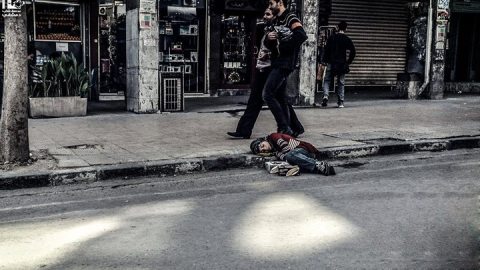"In order to believe what is taking place in Syria, most people need proof in the form of photographs. We provide evidence of crimes in Aleppo by the regime, and also by opposition militias." This is how the activists behind the Lens of a Non-Photographer project explain the reason behind their page. Lens of a Non-Photographer is only part of a growing and varied collection of activists who took the common name, “Lens of…”, and adapted it to their city, work or political views.
“One of the photos that I will never forget is the photo I took of a young girl with blond hair and blue eyes writhing in agony after she was hit with shrapnel,” reflects the activist behind Lens of a Young Saraqebi (from the town of Saraqeb near Idlib). Activists and amateur photographers, armed with nothing but cameras, have been braving the most dangerous of wars to deliver their photographs. As the young man from Saraqeb recounts: “I was once under sniper fire in the liberated area, so it could’ve been either the regime or the Free Syrian Army (FSA).”
Lens of Young Damascene recount their worst moments when they lost several members of their team including Abdullah Dawarah, Mulham Beiram, Youssef Younes and Ahmad Bahesh. “Risk is part of what we do. Sniper fire and bombardment in liberated areas and arrest in areas under regime control. One of our colleagues was hit by a shrapnel while photographing in Jobar. He had to be under treatment for two months,” they recount.
The activist behind Lens of a Young Saraqebi says he was only arrested once, by members of the Islamic State of Syria and Iraq (ISIS). “I was only released after I deleted all the photos I had taken,” the young man retorts, “but we started a revolution against our fear, so this will not frighten us.”
Many of the activists and photographers we interviewed for this piece share one main feature: they identify themselves as amateur photographers who only started their work in photography after the revolution. The activist from Saraqeb says that he started taking it seriously after the overwhelming increase in the “amount of information that needed to be photographed and documented as evidence for the future.”
Most of the groups involve several photographers that collaborate in their work. The majority are also privately funded by their members and are staunchly independent in their work, and their political stances. Some groups, like Lens of a Young Damascene, enjoy a collaborative relationship with local FSA militias that actively protect the photographers and facilitate their work. Others however have a more difficult relationship with the FSA, like Lens of a Young Saraqebi: “I believe this difficulty comes from the fact that I don’t cover up any mistakes of either sides, and I publish photographic evidence of whatever I find. This brrough me secret and public threats.”
The pictures and topics chosen reflect the personal views of each photographer on the events in Syria. Lens of a Non-Photographer focuses on the “destruction wreaked on Aleppo and the human suffering in the city due to the war.” Lens of a Young Damascene also focus on the human side as in the famous photo of a little girl in the aftermath of the chemical weapons massacre in Damascus’s country side. Lens of a Young Saraqebi adapts its work to the security situation in the town. “When it’s quiet I can choose my topics, and I take photographs of what I witness in my tours and walks around the city. But when the situation becomes more dangerous I focus on the devastated areas, the ambulances and the bombs,” he reflects.
Not all of these groups identify themselves with the opposition either. Lens of a Non-Photographer present themselves as strictly neutral in their relationship to the regime and the revolution: “We are neutral. Our goal is not the downfall of the regime, but to achieve national unity and to deliver the truth through photographs. Our only aim, and hope, is that the bloodshed in Syria stops as soon as possible.” Conversely, Lens of a Young Taybani (from the town of Taybat al-Imam in Hama) declare that their goal is to “rid ourselves from the regime and its thugs, as well as those opportunistic forces within the revolution.”
The “Lens” phenomenon that unites these different groups is one of main byproducts of Syria’s revolution. Their documentation of the reality on the ground presents the image of Syria’s tragedy through the eyes of its protagonists. Its effect runs deeper than to simply discredit and supplant traditional media, but to effectively expand the coverage and exposure of what is happening in the country to every corner of it.





